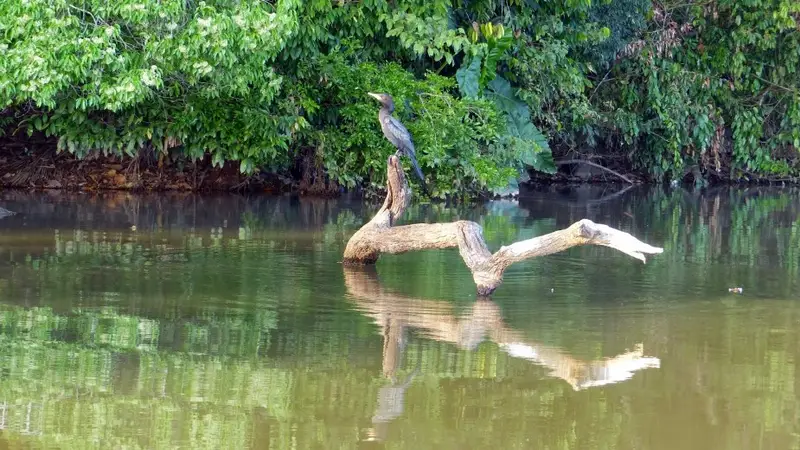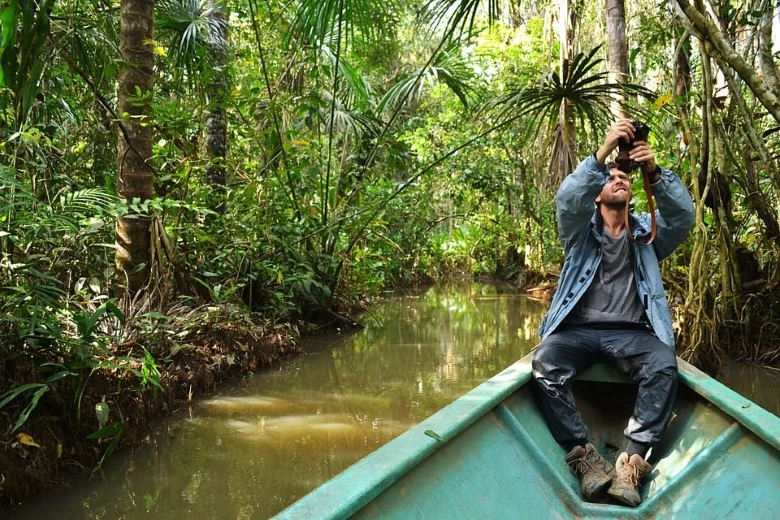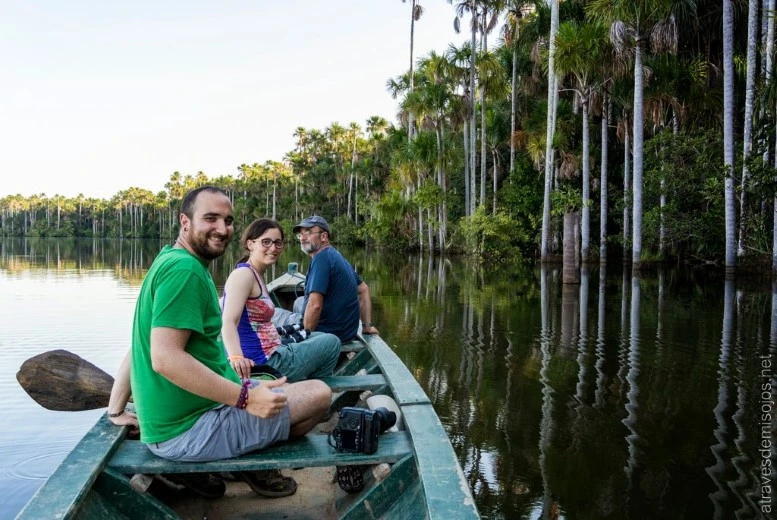Visiting the Tambopata National Reserve in July allows you to enjoy the dry season and ideal weather conditions for photography tours. This month is part of the driest time of the year in the Peruvian Amazon, with stable weather and less rain. With clear skies and pleasant temperatures (28°C during the day and 19°C at night), July is excellent for exploring the rich biodiversity of the tropical rainforest. The lower rainfall makes it easier to spot wildlife in their natural habitat.
Advantages of visiting Tambopata National Reserve in July
- Dry and sunny weather: Less rain makes hikes and river excursions easier. Clear days offer panoramic views and smooth boat rides.
- Better wildlife visibility: During the dry season, animals (birds, mammals, and reptiles) gather around water sources and clay licks, which improves sightings. The reserve is home to over 600 bird species.
- Outdoor activities: Ideal for hiking, kayaking, and photography tours. You can visit the famous Chuncho Macaw Clay Lick to watch hundreds of scarlet macaws each morning, or climb viewing towers to spot harpy eagles and monkeys.
- Perfect season for photography: Strong natural light enhances the jungle’s colors, making photography easier. Many travelers agree that July is perfect for nature and bird photography.

Disadvantages of visiting Tambopata National Reserve in July
- High season: Being the dry season, more tourists visit, so it’s best to book tours and accommodation in advance. Eco-lodges tend to fill up quickly, so early reservations are recommended.
- Intense heat: Midday temperatures can reach up to 32°C, which can be exhausting without good shade. It’s essential to wear sunscreen and stay hydrated.
- Dusty trails: The lack of rain leaves some trails dry and dusty, which can make long walks harder if you’re sensitive to airborne dust.
- Less green vegetation: Compared to the rainy season, the forest looks less lush. Although this increases animal visibility, those seeking dense foliage may notice the vegetation is thinner.

Weather in Tambopata National Reserve in July
- Temperatures: Range between 28°C (high) and 19°C (low) on a typical day.
- Rainfall: There’s only a 20% chance of daily rain, with about 11.7 mm if it occurs. July falls within the low-rainfall season (June to September).
- Sunlight hours: Around 14.8 hours of clear skies per day, making July the sunniest month of the year.
- Daylight duration: The sun rises around 6:59 AM and sets around 6:25 PM, giving about 11.4 hours of daylight.
- Humidity and wind: Relative humidity is around 84% and wind is mild (7.7 kph), resulting in a warm and humid feel.
Birdwatching is one of the main attractions. Each morning, tourists photograph flocks of macaws and parrots at the Chuncho Clay Lick. The high diversity of species in Tambopata draws photographers from all over the world.

Activities in Tambopata National Reserve in July
- Guided jungle walk: Observe century-old trees, medicinal plants, and Tambopata’s wildlife.
- Birdwatching tower: Spot exotic species in their natural environment, from above.
- Night exploration: Search for insects, opossums, night monkeys, owls, and more.
- Stargazing and Milky Way observation: An unforgettable experience under the Amazonian sky.
- Boat ride on the Tambopata River: Scenic navigation with chances of seeing jaguars and anacondas.
- Chuncho Clay Lick: Watch hundreds of macaws and parrots feeding on clay.
- Yacumama Lake exploration: Sunset paddle boat ride with views of birds, black caimans, and more.
- Catch-and-release piranha fishing: Responsible sport fishing for photos.
- Dawn wildlife viewing at Lake Sandoval: Possible sightings of giant otters, caimans, monkeys, macaws, and more.
- Boardwalk hike to Lake Sandoval: A 3-km trail through the jungle, taking about 30 minutes.
- Boat ride on Lake Sandoval: Explore the aquatic and riverside biodiversity.
- Visit to a Matsigenka family: Join cultural activities, including cotton spinning, archery, and fire making.
- Night walk with flashlights: Look for nocturnal wildlife in action.
- Optional morning walk: Observe trees over 700 years old and surrounding flora.
- Canopy bridge experience: Views of the tree canopy and sightings of toucans, hummingbirds, monkeys, and orchids.
- Visit to Monkey Island: Spot primates, turtles, sloths, and other species.
- Night boat safari on the Madre de Dios River: Look for caimans, capybaras, and riverside wildlife.
- La Cachuela Clay Lick: Observe macaws, parrots, toucans, and sloths at dawn.
- Sport fishing in the river: Catch catfish, pacus, and freshwater stingrays.
- Relaxing in hammocks: Rest in the heart of the Amazon rainforest.
Frequently Asked Questions about Tambopata National Reserve in July

1. Do I need a special permit to enter Tambopata National Reserve?
Yes. You need to purchase an eco-admission ticket, which grants access to the protected area. Generally, tour agencies handle this process for travelers as part of the package.
2. Do I need to bring special photography equipment to Tambopata?
Bringing professional equipment is not mandatory. However, a good pair of binoculars or a camera with strong zoom can be very helpful for observing and photographing wildlife, which is often seen from a distance. It’s not essential, since some tours offer lens or gear rentals, especially for visitors interested in nature photography.
3. What are the nights like in Tambopata National Reserve in July?
Nights are mild (around 66°F / 19°C) with high humidity. It’s recommended to use insect repellent due to the presence of bugs. In the jungle, nocturnal animal activity can also be very interesting, especially with the guidance of expert guides.
4. What wildlife can be seen in Tambopata National Reserve in July?
Tambopata National Reserve is home to over 600 bird species, jaguars, monkeys, turtles, and giant river otters. Birdwatching in July is spectacular: every morning, dozens of macaws gather at Chuncho Clay Lick. In lakes and rivers, you can also see herons and aquatic turtles. Wildlife sightings in July are very active, as animals search for food in open areas.
Tours include climbs to observation towers, where you can enjoy panoramic views of the forest and photograph many species from above. This elevated experience allows you to capture birds in flight against the jungle backdrop.
5. How do I get to and move around Tambopata National Reserve?
The most common way is to fly to Puerto Maldonado (about 1 hour and 20 minutes from Lima), then take a boat along the Madre de Dios or Tambopata River. From Puerto Maldonado, the upper sector (where the clay licks are located) is about a 5.5-hour boat ride. Many tours include boat transfers to lodges inside the reserve. Within Tambopata, transportation between stations and trails is done by boat and on foot. It’s essential to hire authorized local guides, who know the routes well and ensure you find the best wildlife viewing spots.
6. What clothes and gear should I bring to Tambopata?
It’s recommended to bring light, comfortable clothing in neutral colors, as well as strong insect repellent and sunscreen. You should also pack a hat or cap, binoculars for birdwatching, and a flashlight for night walks. Mornings can be a bit cool, so a light long-sleeve garment is a good idea. Footwear should be sturdy and closed-toe for hiking. In general, the key is to be prepared for heat and humidity, with protection from the sun and insects.
7. Which tour company is recommended for photography tours in Tambopata?
Peru Jungle Trips is known for its specialized nature photography tours in the Amazon. Its local native guides are trained to assist with bird and mammal spotting in Tambopata. In fact, Tambopata National Reserve in July is an ideal destination for their photo tours. Be sure to hire authorized operators, and Peru Jungle Trips has excellent reviews from international travelers, making it a reliable choice for jungle photography tours.

Visiting Tambopata National Reserve in July is ideal thanks to its dry weather, clear skies, and pleasant temperatures. Wildlife is more visible, and you can enjoy outdoor activities like hiking, kayaking, and photography. However, keep in mind it’s high season and quite hot. Contact us and book your trip to Tambopata National Reserve.
Related tours to Tambopata National Reserve that may interest you:
- Lake Sandoval (2 Days)
- Tambopata Jungle Tour (3 Days)
- Sandoval Lake + Parrot clay lick + Native Community (4 days)
- Collpa Chuncho Macaw Clay Lick + Sandoval Lake & Yacumama Lake (4 Days)
Find out what Tambopata National Reserve is like in June: climate, advantages, and key travel tips for the month.
➜ Tambopata National Reserve in June: Weather, Pros and Cons
Learn what to expect in Tambopata National Reserve in August, right in the heart of the Amazon jungle.
➜ Tambopata National Reserve in August: What to See and Do, Pros and Cons

